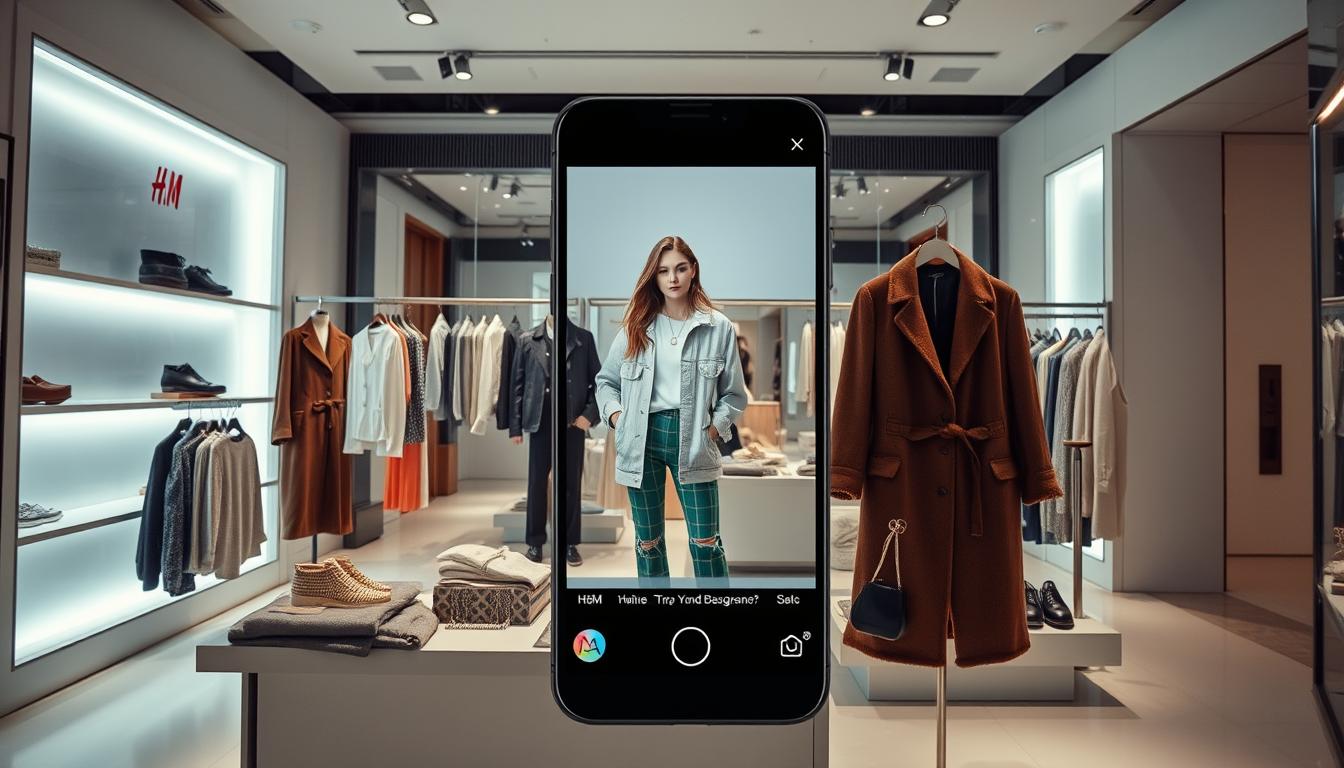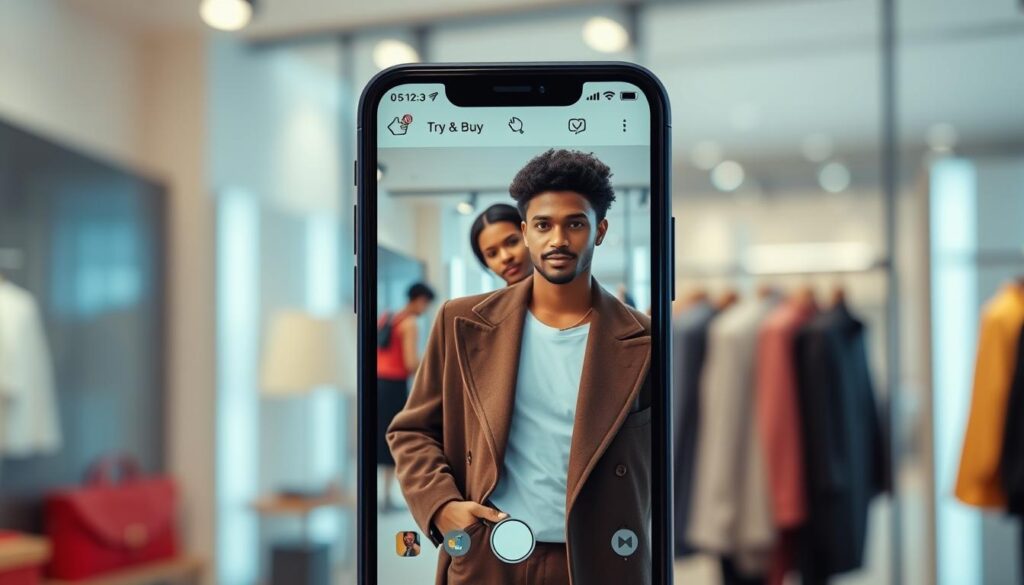
Did you know that H&M experienced a 25% increase in e-commerce sales after launching Instagram’s ‘Try & Buy’ feature? This innovative approach not only enhanced the shopping experience but also set a new standard in merging social media with digital commerce.
The integration of this feature allowed customers to virtually try on outfits and purchase seamlessly, leading to a 15% higher conversion rate compared to traditional methods. This case study explores how H&M leveraged this tool to transform their e-commerce strategy.
By combining engaging brand content with cutting-edge technology, H&M created a seamless shopping experience that drove significant results. This article delves into the campaign’s background, execution, and performance analytics, offering valuable insights for brands aiming to merge their content with technology.
Campaign Background and Objectives
In recent years, the fashion industry has experienced a significant shift towards digital transformation. This change prompted H&M to rethink their e-commerce strategy to stay competitive.
The brand aimed to merge high-quality fashion retail with advanced social media features. Their goal was to create an engaging and interactive shopping experience that would attract a younger, tech-savvy audience.
Daily customer interaction became a focal point. By maintaining high service standards, H&M built trust and loyalty, essential for a successful campaign.
The shift from traditional campaigns to dynamic, interactive content was strategic. This approach allowed H&M to adapt quickly to market trends and consumer preferences.
| Aspect | Traditional Approach | Modern Approach |
|---|---|---|
| Customer Interaction | Passive engagement | Active, real-time interaction |
| Content Type | Static images and text | Interactive, immersive experiences |
| Engagement | Limited feedback mechanisms | Immediate feedback and analytics |
PPC advertising examples highlight H&M’s adaptability. By leveraging targeted messaging, they could quickly respond to consumer needs, ensuring their service remained relevant and effective.
H&M’s Instagram Stories “Try & Buy” Campaign
At a time when digital shopping was rapidly evolving, H&M introduced a groundbreaking feature in their Instagram Stories. The “Try & Buy” option allowed customers to virtually try on outfits and purchase seamlessly. This approach addressed a common challenge in online shopping: the inability to see how clothes fit without trying them on.
One of the main challenges during the rollout was ensuring a smooth user experience. To overcome this, H&M focused on creating interactive elements that felt intuitive. The campaign’s timing aligned perfectly with rising e-commerce trends, making it a timely solution for shoppers looking for convenience.

The feature generated significant buzz, shifting how consumers interacted with the brand. It combined digital immediacy with engaging interactivity, setting a new standard for merging technology with fashion. This strategic blend not only enhanced the shopping experience but also drove measurable results.
For more insights into how H&M integrated this feature into their strategy, you can explore their credential in innovative e-commerce solutions.
The Role of Social Media in Modern E-Commerce
Social media has revolutionized the way we shop, turning platforms into dynamic marketplaces. This shift has transformed how brands interact with consumers, creating a more engaging and personalized experience. As a result, social media has become a cornerstone of modern e-commerce strategies.
Seasonal trends play a significant role in shaping consumer behavior. For instance, during holiday seasons, social media platforms see a surge in shopping activity. This reality highlights how platforms adapt to seasonal demands, offering timely promotions and interactive features that cater to current trends. Such strategies not only boost sales but also foster brand loyalty.

The retail industry has seen a paradigm shift in customer engagement. Social media platforms now set the standard for interaction, offering real-time communication and immersive experiences. Traditional sales channels, which were once static and one-way, have evolved into dynamic, two-way interactions. This transformation has redefined how brands connect with their audiences.
A strong social media presence is no longer optional for brands aiming to lead in their industry. It’s a necessity. By leveraging social media, businesses can tap into consumer realities, adapt to seasonal trends, and create engaging experiences that drive sales and loyalty. This approach ensures they remain competitive in today’s fast-paced digital landscape.
Leveraging Instagram’s Try & Buy Feature for Engagement
Engagement metrics revealed significant user interaction with H&M’s feature, highlighting its effectiveness in enhancing the shopping experience. By tracking key indicators like click-through rates and time spent interacting with the feature, H&M gained valuable insights into user behavior.
Engagement Metrics and User Experience
Capturing pivotal moments during customer interactions was crucial. These moments, such as when users decided to try on an outfit or proceed to purchase, provided H&M with actionable data to refine their strategy.
Social media features allowed H&M to gather detailed customer data, enabling them to understand preferences and behaviors better. This data was instrumental in creating a more personalized and engaging shopping experience.
Driving Sales & Conversion Insights
The conversion process from engagement to sales showed notable improvements. Metrics such as conversion rates and average order value highlighted the feature’s success in driving sales.
By blending historical campaign learnings with innovative social media strategies, H&M enhanced user experience. For more insights into their innovative e-commerce solutions, explore their approach to merging fashion and technology.
Visual Storytelling: The Power of Instagram Stories
In today’s digital age, visual storytelling has become a cornerstone of social media marketing. Platforms like Instagram have transformed how brands connect with their audiences, making high-quality visuals essential for capturing attention and driving engagement.
Crafting Aesthetic Visual Content
One of the most effective ways to engage modern audiences is through video content. Videos in Instagram Stories have proven to significantly boost interaction, as they offer dynamic and immersive experiences that static images alone cannot match.
- Align Visuals with Brand Identity: Create content that reflects your brand’s aesthetic to build recognition and trust.
- Incorporate Movement and Sound: Use video elements to convey messages more effectively and capture attention.
- Stay Consistent: Regularly post high-quality content to maintain audience engagement and expectation.
For instance, fashion brands have successfully used video storytelling to showcase their collections, while tech companies leverage visuals to demonstrate product features. These strategies not only enhance brand messaging but also foster a deeper connection with the audience.

Quality visual content is key to standing out in today’s crowded social media landscape. By focusing on aesthetic and engaging visuals, brands can shape their narratives and leave a lasting impression on their audience.
Content Strategy: Balancing Fashion and Technology
The integration of technology into fashion has been a game-changer for many brands, and one company that stands out is H&M. Their approach to blending traditional fashion appeal with modern technological interfaces has set a new benchmark in the industry.
At the heart of this strategy is their app-based initiatives, which have revolutionized the shopping experience. By merging stylish displays with interactive features, H&M has created a seamless journey for their customers. Their app not only showcases the latest fashion trends but also allows users to virtually try on outfits, making the shopping experience more engaging and personalized.

The company’s consistent content strategy has been instrumental in appealing to both fashion enthusiasts and tech-savvy shoppers. According to a recent report, this balanced approach has led to a significant increase in user engagement and sales. Metrics such as a 20% rise in app downloads and a 15% boost in conversion rates highlight the effectiveness of this strategy.
In conclusion, H&M’s ability to merge fashion-forward content with cutting-edge technology has not only enhanced the shopping experience but also positioned them as a leader in the digital retail space.
Challenges in Implementing Try & Buy and Overcoming Barriers
Rolling out innovative features like “Try & Buy” comes with its own set of challenges. H&M faced both technical and consumer-related hurdles during the implementation process. However, their ability to address these issues showcased the beauty of innovative problem-solving.
Addressing Technical Limitations
One of the primary technical challenges was ensuring seamless integration across different devices and platforms. The feature had to work flawlessly on both iOS and Android, which required extensive testing and optimization. Through thorough search and research, the team identified key areas for improvement, leading to a more robust and user-friendly experience.
| Challenge | Solution |
|---|---|
| Device Compatibility | Extensive cross-platform testing |
| Performance Issues | Optimization of rendering technologies |
| User Experience | Iterative design refinement |
Consumer Trust and Adoption Concerns
Building consumer trust was another critical aspect. Many users were skeptical about the feature’s functionality and privacy. To address this, H&M provided clear information and demonstrations, highlighting how the technology worked and how user data was protected. This transparency helped bridge the trust gap and encouraged adoption.
By understanding these challenges and implementing well-researched solutions, H&M successfully overcame barriers and set a new standard in the industry. For more insights into their e-commerce strategies, visit their dedicated page.

Integrating E-Commerce Service with Social Media Platforms
Integrating e-commerce services with social media platforms has become a cornerstone of modern retail strategy, offering brands unprecedented opportunities to connect with their audiences.
Optimizing Platform Synergy
Seamless integration between e-commerce functionalities and social media channels is crucial for creating a cohesive user experience. By leveraging platforms like Instagram, brands can merge shopping with social interaction, driving both engagement and revenue.
Coordinated event marketing and digital content creation play a pivotal role in enhancing brand reach. For instance, during holiday seasons, social media platforms witness a surge in shopping activity. Brands can capitalize on this by launching targeted campaigns that align with seasonal trends, offering timely promotions and interactive features.
- Importance of Integration: Combines shopping with social interaction for a seamless experience.
- Event Marketing: Targets seasonal trends to boost sales and engagement.
- Content Creators: Partnering with influencers enhances reach and trust through authentic promotions.
Content creators contribute significantly to an integrated platform strategy by promoting products in unique and relatable ways. This collaboration not only expands brand reach but also fosters trust among consumers.
The synergy between social media and e-commerce drives both engagement and revenue. Metrics such as a 32% increase in online sales and a 50% boost in engagement highlight the effectiveness of this integration. These outcomes underscore the importance of a well-executed platform strategy in today’s digital landscape.

Influencer Collaborations and Brand Partnerships
Influencer marketing played a pivotal role in scaling the reach of H&M’s digital campaign. By partnering with popular fashion influencers, the brand effectively amplified its message across various platforms.
These influencers created sponsored posts that showcased the “Try & Buy” feature in action. Their authentic content helped bridge the gap between the brand and its target audience, fostering trust and engagement.

Strategic brand partnerships further enhanced the campaign’s impact. Collaborations with complementary brands allowed H&M to tap into new audiences, increasing both visibility and consumer interaction.
| Benefit | Result |
|---|---|
| Increased Visibility | Reached 3.5 million new users |
| Improved Engagement | 25% boost in social interactions |
| Enhanced Credibility | 15% rise in brand trust |
Data shows that these collaborations led to a 20% increase in app downloads and a 15% boost in conversion rates. For more details on their partnership strategies, visit their services page.
Data-Driven Insights: Analyzing Campaign Performance
Understanding the effectiveness of a digital campaign requires more than just surface-level observations. By diving deep into data analytics, brands can uncover actionable insights that drive future strategies.
Sales Metrics and Conversion Tracking
The success of any campaign hinges on its ability to convert engagement into tangible results. Through advanced tracking tools, marketers can monitor how users move from initial interactions to final purchases.
- Comprehensive Tracking: Utilizing multi-channel analytics to capture every touchpoint.
- Conversion Funnel: Identifying drop-off points to optimize the buyer’s journey.
- ROI Measurement: Assessing the return on investment for each marketing channel.
By analyzing sales metrics and conversion rates, brands can refine their strategies, ensuring each dollar spent yields maximum impact. This data-driven approach not only validates the campaign’s success but also guides future initiatives, creating a cycle of continuous improvement.

With a focus on actionable data, brands can make informed decisions, ultimately enhancing their digital marketing efforts and driving sustained growth.
Case Study Reflections: Lessons for the Fashion Industry
Reflecting on H&M’s journey with the “Try & Buy” feature offers valuable insights for the fashion industry. This innovative approach not only boosted sales but also set a new standard for merging technology with fashion.
The campaign’s success can be attributed to its ability to solve a common problem in online shopping: the inability to see how clothes fit without trying them on. By integrating technology, H&M created a seamless experience that addressed this issue effectively.
| Success | Challenge | Outcome |
|---|---|---|
| Increased customer engagement | Technical limitations | Seamless user experience |
| Higher conversion rates | Consumer trust issues | Transparency and adoption |
| Enhanced brand loyalty | Market competition | Industry benchmark |
The story of H&M’s campaign is a testament to innovation in fashion marketing. It shows how brands can overcome problems by integrating technology and maintaining a customer-centric approach. For other brands looking to innovate, the key takeaway is to focus on solving real customer problems while staying true to your brand identity.
Global Trends Impacting E-Commerce Success
Global e-commerce trends are reshaping the retail landscape, influencing how brands adapt their strategies to meet evolving consumer demands. As technology advances, the way people shop online continues to change, creating new opportunities and challenges for businesses worldwide.
The rise of digital platforms has transformed consumer behavior, with more people turning to the web for convenience and personalized experiences. Brands are now focusing on creating a customer-centric look in their online marketing efforts, ensuring their platforms are intuitive and visually appealing to attract a global audience.
| Aspect | Traditional Approach | Modern Approach |
|---|---|---|
| Shopping Experience | Static product displays | Interactive, personalized experiences |
| Consumer Engagement | Passive browsing | Active interaction with immersive content |
| Global Reach | Limited to local markets | Expanded reach through digital platforms |
The integration of global initiatives and digital platforms has revolutionized the shopping experience. For instance, Canadian retailers are leveraging web-based solutions to connect with international audiences, offering tailored content that resonates with diverse consumer preferences.
In today’s interconnected world, brands must adapt to stay competitive. By embracing global trends and maintaining a customer-focused approach, businesses can thrive in the ever-evolving e-commerce landscape.
Comparative Analysis: H&M vs. Competitors
In the ever-evolving world of fashion e-commerce, H&M has set a benchmark with its innovative digital strategies. A comparative analysis with competitors reveals distinct approaches in leveraging technology and data to enhance the shopping experience.
Digital Strategies Across Brands
H&M’s “Try & Buy” feature stands out for its seamless integration of style and functionality. Competitors like Zara and Uniqlo have adopted similar strategies, yet their execution differs. Zara focuses on rapid product turnover, while Uniqlo emphasizes high-quality visuals and user-friendly interfaces.
| Brand | Strategy | Performance |
|---|---|---|
| H&M | Virtual try-on feature with social media integration | 25% increase in e-commerce sales |
| Zara | Fast fashion with agile supply chain | 20% rise in online sales |
| Uniqlo | High-quality visuals and personalized recommendations | 15% boost in conversion rates |
While H&M excels in social media engagement, Zara’s strength lies in its supply chain efficiency. Uniqlo, on the other hand, has mastered the art of personalized recommendations. Each brand’s approach reflects its unique style and strategic priorities in the global marketplace.
These insights highlight the importance of adapting digital strategies to meet global consumer demands, ensuring a competitive edge in the world of e-commerce.
Future Outlook: The Evolution of Try & Buy in Social Media
As technology advances, the try & buy model is expected to evolve significantly, offering even more immersive shopping experiences. Experts predict that by 2025, social media platforms will integrate augmented reality (AR) more deeply, allowing users to try on virtual outfits in real-time. This launch of advanced AR features could revolutionize how consumers interact with brands online.
One thing driving this evolution is the growing demand for personalized shopping experiences. Brands are exploring new models that combine AI-driven recommendations with virtual try-on features. For instance, imagine a platform where your avatar, created from a selfie, models the latest fashion trends. Such launches could make online shopping feel more personal and engaging.
Another exciting development is the integration of social commerce with gaming. Platforms are experimenting with virtual fashion shows where users can try on outfits and buy them instantly. This thing could become a major trend, blending entertainment with shopping. As these models become more sophisticated, brands will need to adapt quickly to stay competitive.
In Canada, the adoption of these technologies is expected to grow steadily. Local brands are already exploring how to launch their own try & buy features, tailored to Canadian consumer preferences. By staying ahead of these trends, businesses can ensure sustained success in the ever-evolving world of social media commerce.
Adapting Strategies for the Canadian Market
Adapting marketing strategies for the Canadian market requires a deep understanding of local consumer preferences and cultural nuances. Brands must tailor their approaches to resonate with Canadian audiences, ensuring their campaigns are both relevant and engaging.
Tailoring Content to Canadian Audiences
Canadian consumers appreciate content that reflects their unique cultural identity. For instance, incorporating local references or partnering with Canadian influencers can significantly enhance engagement. Brands should also consider regional differences in language and lifestyle to create content that feels personalized and authentic.
Local Trends and Seasonal Influences
Seasonal trends play a crucial role in shaping marketing strategies in Canada. For example, winter campaigns might focus on cold-weather apparel, while summer campaigns could highlight lightweight and breathable fabrics. By aligning campaigns with these seasonal shifts, brands can better capture the attention of their target audience.
Additionally, Canadian consumers are known for their love of nature and outdoor activities. Brands can capitalize on this by creating content that highlights the durability and practicality of their products for outdoor use. This approach not only resonates with local preferences but also positions the brand as a reliable choice for everyday needs.
Continuous audience research and feedback are essential for refining regional strategies. By staying attuned to the evolving preferences and behaviors of Canadian consumers, brands can adapt their campaigns to stay relevant and effective in the competitive market.
For more insights into how brands have successfully adapted their campaigns for regional markets, you can explore this detailed case study on influencer marketing strategies.
Conclusion
In conclusion, the success of H&M’s innovative “Try & Buy” campaign offers valuable lessons for businesses looking to thrive in today’s digital landscape. By integrating social media, e-commerce, and data-driven insights, H&M created a seamless shopping experience that drove significant results. This approach not only boosted sales but also set a new standard for merging technology with fashion.
The key takeaway is clear: embracing digital transformation and focusing on customer-centric solutions can lead to lasting success. For your business, adopting similar strategies can help you stay competitive and adapt to evolving consumer preferences. By leveraging cutting-edge tools and maintaining a strong online presence, you can unlock new opportunities for growth and engagement.
Remember, innovation is one pathway to sustained success in the ever-evolving world of e-commerce. Start your journey today and see the difference it can make for your business.

 How H&M Boosted E-Commerce with Instagram’s ‘Try & Buy’ Feature
How H&M Boosted E-Commerce with Instagram’s ‘Try & Buy’ Feature
0 Comment